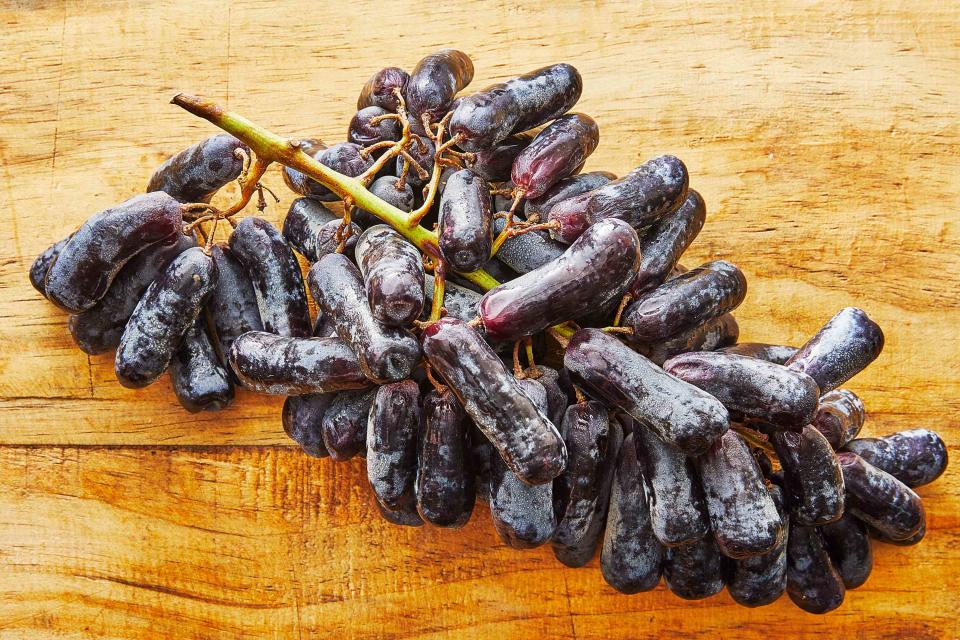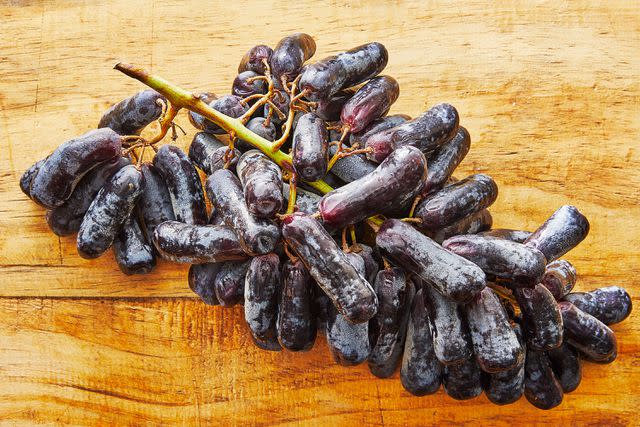What Are Moon Drop Grapes?
These funny looking grapes are a delicious treat.

Caitlin Bensel; Food Styling: Torie Cox
If you’ve spotted grapes in the produce aisle that are much more cylindrical than the usual varieties, then you’ve seen Moon Drop grapes, also known as Sweet Sapphire. First developed in California in 2004, Moon Drop’s unique elongated shape definitely helps it stand out among the other grape varieties.
What Are Moon Drop Grapes?
A type of black grape that largely is available in late summer and fall, Moon Drops look like an elongated tube with a dimpled end. They have a number of qualities that make them a fantastic choice for anyone who loves snacking on fruit, such as being seedless and having a sweeter and stronger grape flavor than most black grapes.
This new strain of grapes was also developed to last longer in transport and storage than other commercially popular varieties. That means that once they’re in your fridge, they should last for quite a while.
Want to know more about this new variety of grape? Read on to learn how they were created, how they taste, and how to incorporate them into your everyday snacking routine.

Caitlin Bensel; Food Styling: Torie Cox
How Were Moon Drop Grapes Developed?
Moon Drops are the product of agricultural experimentation and cross-breeding, but they are not genetically modified plants. These grapes first came into existence in 2004, created by International Fruit Genetics (IFG), which was founded by Dr. David Cain in 2000. So while their shape, texture, or taste might seem like a GMO invention, they are simply an example of the kind of fruit nature will grow if given a nudge.
Unfortunately, Moon Drops cannot be grown at home. They are under patent protection until at least 2031.
Related: Scuppernong Grapes Are the Stuff of Southern Legend
Why Are They Called Moon Drop Grapes?
IFG developed the grapes and trademarked them as Sweet Sapphire, a name they are sometimes sold under in other countries. Here in the U.S., the grapes are produced by the Grapery in California, which packages them under the name Moon Drops for selling in stores. It’s possible that the grapes received the name because of their vague resemblance to a water drop. The Grapery also produces a green grape called Tear Drops that has a similar shape.
In my local stores, shoppers seemed to largely refer to them as “long grapes.”
What Do Moon Drop Grapes Taste Like?
On average, Moon Drops are sweeter and have a more intense grape flavor than more readily available varieties, like Concord. For me, Moon Drops consistently tasted like concentrated Welch’s grape juice that had been mixed with less water than directed. That slightly candy-ish flavor is comparable to the Cotton Candy grapes (also an IFG creation) that have also been developed through artificial hybridization over the years.
Picky eaters, people with sensory issues, and those who struggle with texture may find a friend in Moon Drop grapes because of the way they have been developed. In general, Moon Drops have a firmer texture than other varieties of grapes. Some you are even able to snap in half.
They are also seedless and consistently firm yet yielding throughout. For those who find it difficult to eat fruit with inconsistent textures, Moon Drop grapes may be a way to add produce back into the snacking repertoire.
What To Look For When Choosing Moon Drop Grapes
As mentioned earlier, Moon Drops were developed to last a long time and be extra durable during shipping and storage. That being said, it’s still fruit and does eventually go bad, and it can still be damaged in transit.
When picking out Moon Drops at the store, look for grapes that are oblong with a slight dimple at the end. The grapes should be plentiful on each bunch, and each grape should be firm. Loose grapes that have fallen off the bunch should be checked to make sure they have not started to turn.
Once home, Moon Drops should last quite a while when stored correctly. I was able to enjoy them for about two weeks before the last few began to wrinkle. Kept properly, these grapes can become a great addition to your fruit rotation.
Related: Broccoli, Grape, And Pasta Salad
For more Southern Living news, make sure to sign up for our newsletter!
Read the original article on Southern Living.

